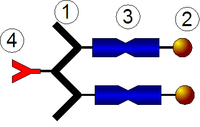
Photo from wikipedia
Protein nanocages represent a class of nanovehicles for a variety of applications. However, precise manipulation of self-assembly behavior of these protein nanocages in response to multiple external stimuli for custom-tailored… Click to show full abstract
Protein nanocages represent a class of nanovehicles for a variety of applications. However, precise manipulation of self-assembly behavior of these protein nanocages in response to multiple external stimuli for custom-tailored applications remains challenging. Herein, we established a simple but effective strategy for controlling protein nanocage self-assembly that combines a dual property of His motifs (their significantly pH-dependent protonation state and their capacity to coordinate with transition metals) with its high symmetry. With this strategy, we enabled two different ferritin nanocages to disassemble into protein tetramers under neutral solution by introducing His6 motifs at the 4-fold channel interfaces. Notably, these tetramers are able to self-assemble into ferritin-like protein nanocages in response to multiple external stimuli such as transition metal ions and pH, and vice versa, indicative of a reversible self-assembly process. Furthermore, such His-mediated reversible protein self-assembly has been explored for encapsulation of bioactive cargo molecules within these reconstituted protein nanocages with higher loading efficiency under milder conditions as compared to the reported acid denaturation encapsulation method for ferritin.
Journal Title: ACS nano
Year Published: 2020
Link to full text (if available)
Share on Social Media: Sign Up to like & get
recommendations!